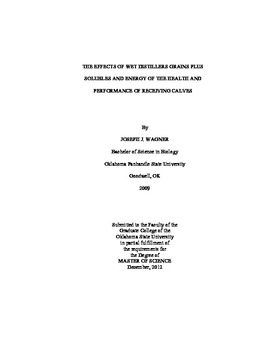| dc.description.abstract | A randomized complete block design experiment utilizing 180 high-risk crossbred steers (initial BW = 212 ± 2 kg) was conducted to evaluate the effects of including wet distillers grains plus solubles (WDGS) in a 62% concentrate receiving diet on steer performance and health over a 42 d period. Experimental treatments consisted of receiving diets with inclusion of 0%, 15%, or 30% WDGS replacing dry-rolled corn, liquid supplement and a portion of dry supplement. Average daily gain, DMI, G:F, and animals treated for BRD (P > 0.10) did not differ among treatments for 0, 15, or 30% WDGS, respectively. Dry matter intake differed (P = 0.04; 4.67 vs. 5.16 kg/d, respectively) differed and there tended to be differences (P = 0.07; 0.46 vs. 0.49 kg/d, respectively) in ADG between control steers and those fed WDGS. Feeding WDGS receiving diets to high-risk calves did not negatively impact animal health or performance. A second experiment was conducted to determine the effects of altering hay, corn, Sweet Bran® levels in high byproduct diets on the health and performance of receiving calves. In a randomized complete block design experiment, 476 crossbred calves (initial BW = 231 ± 4 kg) were blocked by source and arrival BW before being randomly assigned to 1 of 4 receiving diet treatments, which were fed for 49 d. Experimental treatments consisted of: a base diet containing 20.0% dry-rolled corn, 14.8% prairie hay, 59.1% Sweet Bran® and 6.15% dry supplement; the base diet with WDGS replacing corn; 20% WDGS replacing a portion of hay and Sweet Bran® from the base diet; or inclusion of 40% corn and 20% WDGS replacing a portion of the hay and Sweet Bran®. There were no differences (P > 0.10) in overall performance or health between the low concentrate diets. Percentage of calves treated at least once were not different (P = 0.13) among treatments. When low concentrate diets were combined there was a linear increase (P < 0.05) in antimicrobial treatments with increasing concentrate level. There was no difference (P = 0.75) in DMI, but as diet concentrate increased there was a linear increase in ADG (P = 0.03) and feed efficiency (P < 0.01). Similar to previous experiments, it appears that ADG and efficiency are improved with increasing energy density in diets for receiving calves, but health is negatively impacted. | |
